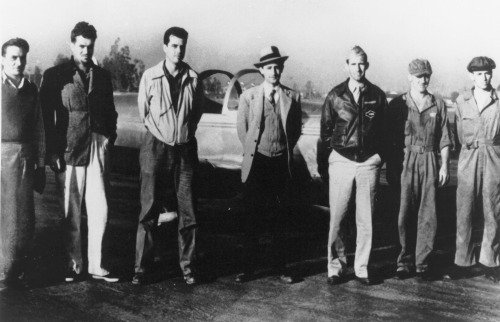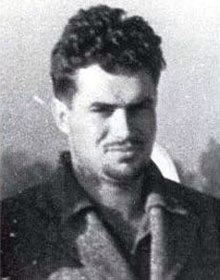The suicide squad we know is the movie based on the DC comics :

But the real Suicide squad is someone who are reason or the ones who laid the foundation for rocket science.

Our story starts here:
In the interest of time I'm going to summarize some things until we get to the interesting bits after this paragraph. A talented self taught chemist at Caltech named John Whiteside Parsons (folks called him Jack) along with colleagues, Frank Malina and Edward Forman wanted to make a liquid fuel rocket motor. However they lacked the funding so they decided to approach Caltech with the idea. The head of GALCIT (Guggenheim Aeronautical Laboratory-Caltech), Theodore von Karman gave permission for the group to work together on the subject.

Image: Jack parson.
With some effort the men came up with the basic funding needed and secured a test site behind the Devil's Gate Dam in Pasadena CA. As it happens this site is pretty close to the JPL test site still used today. Soon the team was re-enforced by two more scientists from GALCIT: Weld Arnold and Hsue Shen Tsien. The Suicide Squad was now complete.
Far from being starry-eyed dreamers, Frank Malina, Jack Parsons, and Ed Forman were as serious as they were technically gifted. Malina was a grad student at Caltech who hoped to write his Ph.D. dissertation on rocket propulsion. His fascination with spaceflight had been aroused when, as a 12-year-old living in Czechoslovakia, he read a translated version of Jules Verne’s From the Earth to the Moon. Throughout the space craze of the late 1920s and ’30s, Malina had devoured everything he could find in the popular press about rocketry and spaceflight.
His two friends weren’t students, but self-taught chemists and rocketry enthusiasts who had approached Malina for technical advice. After a few days of thinking over their proposal, von Kármán granted his approval for Malina to do his dissertation on rocketry, and specifically to design a high-altitude sounding rocket with the help of Parsons and Forman. So began a most ambitious enterprise known as the Caltech Rocket Research Project, which soon involved other talented students doing pioneering work in solid- and liquid-fuel propulsion.
Parsons was one of the principal founders of both the Jet Propulsion Laboratory (JPL) and the Aerojet Engineering Corporation. He invented the first rocket engine to use a castable, composite rocket propellant,[1] and pioneered the advancement of both liquid-fuel and solid-fuel rockets.
In 1942 they founded Aerojet to develop and sell their JATO technology; the GALCIT Group became JPL in 1943.
Parsons was considered effeminate as a child; in adult life he exhibited an attitude of machismo.[162] His FBI file described him as "potentially bisexual" and he once expressed experiencing a latent homosexuality.[61] The actor Paul Mathison said he had had a gay relationship with Parsons in the 1950s, though this was disputed by others who knew him and Cameron.[163] Parsons had the reputation of being a womanizer, and was notorious for frequently flirting and having sexual liaisons with female staff members at JPL and Aerojet.[164][165] He was also known for personal eccentricity such as greeting house guests with a large pet snake around his neck, driving to work in a rundown Pontiac, and using a mannequin dressed in a tuxedo with a bucket labelled "The Resident" as his mailbox.
Parsons treated magic and rocketry as different sides of the same coin: both had been disparaged, both derided as impossible, but because of this both presented themselves as challenges to be conquered. Rocketry postulated that we should no longer see ourselves as creatures chained to the earth but as beings capable of exploring the universe. Similarly, magic suggested there were unseen metaphysical worlds that existed and could be explored with the right knowledge. Both rocketry and magic were rebellions against the very limits of human existence; in striving for one challenge he could not help but strive for the other.
The company’s low-cost, high-performance solid-fuel JATOs were a phenomenal success. They were manufactured by the thousands for both military and civilian airplanes, including commercial airliners. Aerojet also became one of America’s leading pioneers in the development of both liquid- and solid-fuel rocket power plants for missiles, sounding rockets—notably the famous Aerobee series that was in service for almost 40 years—and even large launch vehicles like the Titan that boosted Gemini astronauts into orbit.
Ultimately, Aerojet, whose 75th anniversary we celebrate this month, got caught up in the wave of mergers that went through the aerospace industry starting in the 1990s. In 2013 it merged with Pratt & Whitney Rocketdyne, and today it’s known as Aerojet Rocketdyne.
Source: https://en.wikipedia.org/wiki/Jack_Parsons_(rocket_engineer)